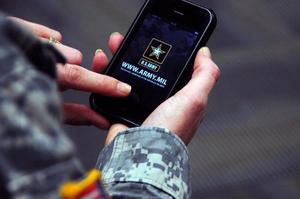In the trenchesArmy mobilizing smart phones for combat
The U.S. Army is actively working to mobilize smart phones and apps to help soldiers on the battlefield; the Department of Defense currently operates an application store that features various apps that help monitor mental health and gather intelligence on allied and enemy movements; the Army has launched a program called Apps for Army, which encourages soldiers and civilians to help design apps; it also provides training for app development; the Army is hoping to expand app development and is discussing the idea to issue smart phones to every soldier; contractors like Raytheon are eager to enter this emerging market

Smart phones join the ranks with military apps // Source: time.com
The U.S. Army is actively working with soldiers and contractors to develop innovative new smart phone apps that would help soldiers communicate, gather intelligence, or identify enemy combatants.
With the prevalence of smart phones like the Android or Apple’s iPhone, the Army has begun developing apps that increase information access, location awareness, and training.
The Department of Defense currently runs an application storefront that carries apps like the Telehealth Mood Tracker, which helps soldiers check their psychological wellbeing and combat rising suicide rates. Other apps include the Movement Projection app which allows soldiers to see where their allies are and spot enemies.
These apps were the outcome of a program called Apps for Army, which enabled soldiers and civilians the ability to help build apps for military use.
Lt. Col. Greg Motes of the Army Signal Center at Fort Gordon said, “We’re really in spring training at this point,” as, “we’d never done anything with apps before.”
Col. Motes believes that apps will eventually be able to control jets, tanks, or machine guns in addition to being used for facial recognition of enemy combatants or as a finger print scanner for prisoners.
“This isn’t the future. This is now,” he said.
The Army is so enthusiastic about the prospects of harnessing smart phones and apps that it is discussing the potential of issuing smart phones to every soldier. It has already set a goal to issue these devices to some soldiers by the end of 2011.
Common smart phones like the Android or Apple’s iPhone have been proven to be durable enough to stand up to the rigors of the battle field, as soldier are already carrying them for individual use.
According to Col. Marisa Tanner, the chief of the doctrine, organization, operational architecture and threat division at the Future Force Integration Directorate located at Fort Bliss, “The soldiers, they protect these phones like they’re a weapon.”
Turner says, “They’ll have it on their bodies at all times,” strapping it to their arms, legs, helmets, or even weapons.
The Army is encouraging soldiers to develop their own apps and is even offering courses in application development.
The private sector is also eager to participate. “The commercial industry is chomping at the bit to meet our needs,” Col. Tanner said.
Contractors have the expertise to design sophisticated apps, while increased competition could help to reduce prices and the time it takes to deliver apps to soldiers.
Raytheon is looking to expand its burgeoning military app business. It is currently designing the Raytheon Advanced Tactical System which features twelve apps. These apps include features that allow soldiers to track their allies or share camera footage with others to pool intelligence.
Mark Bigham, Raytheon‘s vice president of business development, says this is “an important, emerging technology,” and “it represents a new way of doing business.”
The Army is exploring several ways to more effectively integrate these devices onto the battlefield.
It is currently testing small generators that could power their phones for a week at a time rather than a few hours.
The Army also recently deployed an experimental new solar powered backpack in July to Afghanistan. The backpack, called the Rucksack Enhanced Portable Power Systems, contains a solar panel capable of generating sixty-two watts of energy to charge phones.
